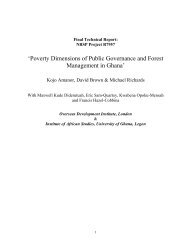Feasibility study on a capital-based income generation scheme for ...
Feasibility study on a capital-based income generation scheme for ...
Feasibility study on a capital-based income generation scheme for ...
Create successful ePaper yourself
Turn your PDF publications into a flip-book with our unique Google optimized e-Paper software.
ANALYSIS OF LIVELIHOOD RECOVERY NEEDS AND PROGRAMMES IN TRINCOMALEE DISTRICT<br />
2.3. Detailed analysis of extremely poor households<br />
2.3.1. Analysis of their structure and <strong>income</strong><br />
From a list of households classified as extremely poor and lacking labour power that was<br />
given by village leaders in Faisal Nagar and Gopalaporum, 48 were interviewed. For details<br />
<strong>on</strong> the survey methodology used see Appendix 3. It turned out that 21 of the interviewed<br />
households had either no adult fit <strong>for</strong> work or had a gender-adjusted dependency ratio of<br />
over four, while 27 had a ratio of four or lower.<br />
The dependency ratio is the relati<strong>on</strong> between the total number of household members and<br />
the number of household members fit <strong>for</strong> <strong>income</strong> generating work (potential breadwinners).<br />
Those fit <strong>for</strong> <strong>income</strong> generating work are all household members aged 18 to 60 years who<br />
are physically and mentally fit. However, taking social and religious norms into account,<br />
women are <strong>on</strong>ly calculated at being half (50 per cent) fit <strong>for</strong> work. The <strong>for</strong>mula to calculate<br />
the gender-adjusted dependency ratio is:<br />
Total number of household members<br />
Men fit <strong>for</strong> work + women fit <strong>for</strong> work<br />
2<br />
The households with a dependency ratio over four are classified <strong>for</strong> the purpose of this <str<strong>on</strong>g>study</str<strong>on</strong>g><br />
as extremely poor and labour-scarce. An analysis of the household structure and <strong>income</strong> of<br />
each of the 21 households is given in Appendix 10. The households with a dependency ratio<br />
of four and lower are classified as extremely poor with labour. An analysis of the household<br />
structure and <strong>income</strong> of the 27 households in this category is given in Appendix 11. For both<br />
groups of households, the <strong>income</strong> data given do not include the tsunami-related government<br />
and WFP transfers, but all other earned and transfer <strong>income</strong>s.<br />
A comparis<strong>on</strong> of the two groups of households classified by the community leaders as<br />
extremely poor leads to the following c<strong>on</strong>clusi<strong>on</strong>s:<br />
• The total <strong>income</strong> per pers<strong>on</strong> in both groups varies between no <strong>income</strong> and Rs3,000 per<br />
pers<strong>on</strong> per m<strong>on</strong>th. Those without <strong>income</strong> live entirely <strong>on</strong> the current tsunami relief<br />
transfers (which will leave them without <strong>income</strong> when they are disc<strong>on</strong>tinued).<br />
• Using the official inflati<strong>on</strong>-adjusted poverty line of Rs1,650 per pers<strong>on</strong> per m<strong>on</strong>th, all<br />
but five of the households with labour and six of the labour-scarce households fall<br />
below the poverty line<br />
• N<strong>on</strong>e of the households with labour reports earnings from child labour, while three of<br />
the labour-scarce households have substantial <strong>income</strong> from child labour. When <strong>income</strong><br />
from child labour is excluded, the number of labour-scarce households over the poverty<br />
line is reduced to just three; and two of these households received substantial transfers<br />
from relatives.<br />
• Incomes earned by adult males are, in both groups, two to three times higher than those<br />
earned by adult females.<br />
• Unearned <strong>income</strong> received from relatives, the community or begging is an important<br />
source of <strong>income</strong> <strong>for</strong> half the labour-scarce households, but <strong>for</strong> <strong>on</strong>ly 20 per cent of the<br />
households with labour.<br />
23
















